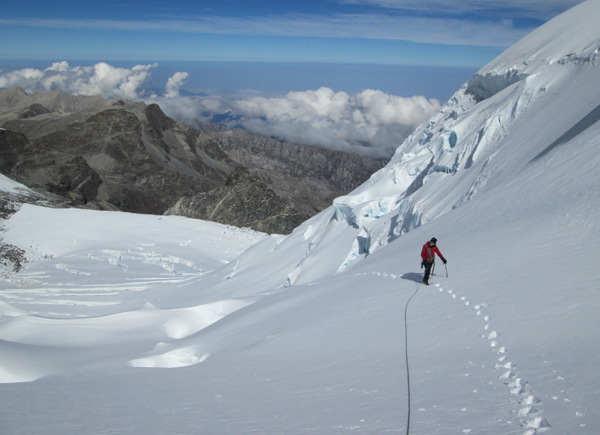|
List Of Ultras Of South America
This is a list of the 209 ultra prominent peaks, or Ultras in South America. An ''Ultra'' is a mountain summit with a topographic prominence of or more. Guiana Highlands Sierra Nevada de Santa Marta, Cordillera Oriental, Cordillera de Mérida, and Coastal Range Cordillera Occidental and Cordillera Central Cordilleras of Ecuador Galápagos Cordillera Blanca and northern Peru Cordillera Oriental Cordillera Occidental Brazilian Highlands Puna de Atacama to Aconcagua Mid Argentina and Chile south of Aconcagua Northern Patagonia Southern Patagonia References Lists - South America {{Lists of Ultras |
Ultra-prominent Peak
An ultra-prominent peak, or Ultra for short, is a mountain summit with a topographic prominence of or more; it is also called a P1500. The prominence of a peak is the minimum height of climb to the summit on any route from a higher peak, or from sea level if there is no higher peak. There are approximately 1,524 such peaks on Earth. Some well-known peaks, such as the Matterhorn and Eiger, are not Ultras because they are connected to higher mountains by high cols and therefore do not achieve enough topographic prominence. The term "Ultra" originated with earth scientist Steve Fry, from his studies of the prominence of peaks in Washington in the 1980s. His original term was "ultra major mountain", referring to peaks with at least of prominence. Distribution Currently, 1,518 Ultras have been identified above sea level: 639 in Asia, 356 in North America, 209 in South America, 120 in Europe (including 12 in the Caucasus), 84 in Africa, 69 in Oceania, and 41 in Antarctica. Man ... [...More Info...] [...Related Items...] OR: [Wikipedia] [Google] [Baidu] |
Cerro Raya
Cerro is Spanish for "hill" or "mountain". Toponyms ;Bolivia: * Cerro Rico, the "Rich Mountain" containing silver ore near Potosi, Bolivia ;Brazil: * Cerro Branco, a municipality of Rio Grande do Sul * Cerro Grande, Rio Grande do Sul, a municipality of Rio Grande do Sul * Cerro Largo, a municipality of Rio Grande do Sul ;Chile * Cerro de Los Inocentes, in the Juan Fernández Islands ;Cuba: * Cerro, Havana, a district (''municipio'') ;Italy: *Cerro (Bottanuco), a subdivision of Bottanuco in the province of Bergamo * Cerro al Lambro, in the province of Milano *Cerro al Volturno, in the province of Isernia *Cerro Maggiore, in the province of Milano * Cerro Tanaro, in the province of Asti *Cerro Veronese, in the province of Verona ;Mexico: * Cerro Potosí ;United States: * Cerro, New Mexico ;Uruguay: * Cerro Largo Department * Villa del Cerro, in Montevideo * Fortaleza del Cerro, in Montevideo Football clubs * C.A. Cerro, a football club from Montevideo, Uruguay * Club Cer ... [...More Info...] [...Related Items...] OR: [Wikipedia] [Google] [Baidu] |
Cerro Tristeza
Cerro Tristeza is a mountain in South America. It has an elevation of above sea level. Cerro Tristeza lies within the coastal state of Sucre, Venezuela, near the border with the Venezuelan state of Anzoátegui. See also * List of Ultras of South America This is a list of the 209 ultra prominent peaks, or Ultras in South America. An ''Ultra'' is a mountain summit with a topographic prominence of or more. Guiana Highlands Sierra Nevada de Santa Marta, Cordillera Oriental, Cordillera de Mér ... References External links * Tristeza Geography of Sucre (state) {{Venezuela-geo-stub ... [...More Info...] [...Related Items...] OR: [Wikipedia] [Google] [Baidu] |
Ritacuba Blanco
Ritacuba Blanco is the highest peak of Cordillera Oriental, in the Andes Mountains of Colombia. It's also named Ritak'uwa, an ancient name from the U'wa indigenous people that live in the lowlands of the National Park Sierra Nevada del Cocuy y Güicán, where the Ritacuba Blanco is located. The summit is accessible from the west via the town of El Cocuy, the village of Güicán, and the hamlet of Las Cabañas. The hike is fairly easy, but the weather is not reliable, and a glacier must be crossed. Because of global warming, its glacier is melting at very high rates, backing down 25 linear mts per year; the same is happening at amazing speeds to all other snow-covered tropical mountains in Colombia. In 1950, Ritacuba Blanco's glacier extended down to above sea level; in January 2007 its lowest point was at above sea level. If this melting rate continues, the glacier is expected to disappear before 2055. Directions to access the mountain You can access Ritacuba Blanco ei ... [...More Info...] [...Related Items...] OR: [Wikipedia] [Google] [Baidu] |
Pico Bolívar
Pico Bolívar is the highest mountain in Venezuela, at 4,978 metres (16,332 ft).Pérez et al (Sep. 2005)"Alturas del Pico Bolívar y otras cimas andinas venezolanas a partir de observaciones Gps."INCI v.30, n.4, Caracas sep. 2005. Retrieved 2012-09-27. Located in Mérida State, its top is permanently covered with névé snow and three small glaciers. It can be reached only by walking; the Mérida cable car, which was the highest and longest cable car in the world when it was built, only reaches Pico Espejo. From there it is possible to climb to Pico Bolívar. The peak is named after the Venezuelan independence hero Simón Bolívar. The Pico Bolívar is located on the mountain previously called La Columna, next to El León (4,743 m) and El Toro (4,695 m). The new name was suggested by Tulio Febres Cordero in 1925. It was officially renamed on December 30, 1934. Elevation The height of this prominent Andean peak has been estimated and calculated various times during histor ... [...More Info...] [...Related Items...] OR: [Wikipedia] [Google] [Baidu] |
Pico Cristóbal Colón
Pico Cristóbal Colón is the highest mountain in Colombia, with an estimated height of . Pico Cristóbal Colón and Pico Simón Bolívar are the two highest peaks in Colombia and are equal in elevation. One or the other of these peaks is therefore the fifth most prominent in the world (see list of peaks by prominence). The nearest peak that is higher is Cayambe, some away. There is a permanent snowcap on this peak and on the nearby mountains. It is part of the Sierra Nevada de Santa Marta range, along with Pico Simón Bolívar. The peak is named after Christopher Columbus. Climbing history Colón was first climbed in 1939 by Walter Wood, Anderson Bakerwell and E. Praolini. Access to these mountains became very difficult after the early 1990s due to hostile locals, drug traffickers, and FARC guerillas. An expedition in 2015 led by John Biggar was one of the first to climb in the range for many years, and reached the summit of Pico Colón on 13 December. See also * List o ... [...More Info...] [...Related Items...] OR: [Wikipedia] [Google] [Baidu] |
Scratching The Sky
Scratching, sometimes referred to as scrubbing, is a DJ and turntablist technique of moving a vinyl record back and forth on a turntable to produce percussive or rhythmic sounds. A crossfader on a DJ mixer may be used to fade between two records simultaneously. While scratching is most associated with hip hop music, where it emerged in the mid-1970s, from the 1990s it has been used in some styles of rap rock, rap metal and nu metal. In hip hop culture, scratching is one of the measures of a DJ's skills. DJs compete in scratching competitions at the DMC World DJ Championships and IDA (International DJ Association), formerly known as ITF (International Turntablist Federation). At scratching competitions, DJs can use only scratch-oriented gear (turntables, DJ mixer, digital vinyl systems or vinyl records only). In recorded hip hop songs, scratched "hooks" often use portions of other songs. History Precursors A rudimentary form of turntable manipulation that is related to sc ... [...More Info...] [...Related Items...] OR: [Wikipedia] [Google] [Baidu] |
Venezuelan Coastal Range
The Venezuelan Coastal Range ( es, Cordillera de la Costa or ), also known as Venezuelan Caribbean Mountain System ( es, Sistema Montañoso Caribe) is a mountain range system and one of the eight natural regions of Venezuela, that runs along the central and eastern portions of Venezuela's northern coast. The range is a northeastern extension of the Andes, and is also known as the Maritime Andes. It covers around 48,866 km2, being the 4th largest natural region in Venezuela. Geography The Coastal Range actually consists of two parallel ranges, which run east and west along the coast of the Caribbean Sea. The Cojedes River separates the western end of Coastal Range from the Cordillera de Mérida to the southeast. The range is divided into eastern and western sections by the wide bay between Cape Codera and Cumaná. Serranía del Litoral—Serranía del Interior In eastern section of the range, the parallel ranges are known as the Serranía del Litoral, which runs along the Caribbe ... [...More Info...] [...Related Items...] OR: [Wikipedia] [Google] [Baidu] |
Cordillera De Mérida
The Cordillera de Mérida is a series of mountain ranges, or massif, in northwestern Venezuela. The Cordillera de Mérida is a northeastern extension of the Andes Mountains and the most important branch of the Venezuelan Andes. The ranges run southwest–northeast between the Venezuelan-Colombian border and the Venezuelan Coastal Ranges. The Táchira depression separates the Cordillera de Mérida from the Cordillera Oriental, which forms the Colombia-Venezuela border. The ranges runs from southwest to northeast and parts lie within each of the following states: Táchira, Mérida, Barinas, Trujillo, Portuguesa and Lara. The southeastern slopes are drained by tributaries of the Orinoco River, while the streams that drain the northwestern slopes empty into Lake Maracaibo. At the northeast tip of the massif lies the town of Barquisimeto and the headwaters of the River Cojedes. In the centre of the massif is the city of Mérida. Two ranges of peaks lie on either side of the city, ... [...More Info...] [...Related Items...] OR: [Wikipedia] [Google] [Baidu] |
Cordillera Oriental (Colombia)
The Cordillera Oriental ( en, Eastern Ranges) is the widest of the three branches of the Colombian Andes. The range extends from south to north dividing from the Colombian Massif in Huila Department to Norte de Santander Department where it splits into the Serranía del Perijá and the Cordillera de Mérida in Venezuelan Andes. The highest peak is Ritacuba Blanco at in the Sierra Nevada del Cocuy. Geography The western part of the Cordillera Oriental belongs to the Magdalena River basin, while the eastern part includes the river basins of the Amazon River, Orinoco River, and Catatumbo River. Within it, the Altiplano Cundiboyacense and the Sierra Nevada del Cocuy (with the only snowy peaks in this mountain range) stand out. The mountain range contains the most páramos in the world. Protected areas * Cueva de los Guácharos * Chingaza National Natural Park * Yariguíes National Park * Sierra Nevada del Cocuy * Sumapaz Páramo * Tamá National Natural Park * Los Estoraques Uni ... [...More Info...] [...Related Items...] OR: [Wikipedia] [Google] [Baidu] |
Sierra Nevada De Santa Marta
The Sierra Nevada de Santa Marta (English: ''Snow-Covered Mountain Range of Saint Martha'') is an isolated mountain range in northern Colombia, separate from the Andes range that runs through the north of the country. Reaching an elevation of just from the Caribbean coast, the Sierra Nevada is the highest coastal range in the tropics, and one of the highest coastal ranges in the world, being shorter than the Saint Elias Mountains in Canada. The Sierra Nevada encompasses about and serves as the source of 36 rivers. The range is in the Departments of Magdalena Department, Magdalena, Cesar Department, Cesar and La Guajira Department, La Guajira. The highest point of the Sierra Nevada group (and Colombia in general) may be either Pico Cristóbal Colón or Pico Simón Bolívar, both in the municipalities of Santa Marta and Aracataca; it has yet to be determined which is higher. SRTM data and local topographic maps show that their true elevations are approximately , lower than the ... [...More Info...] [...Related Items...] OR: [Wikipedia] [Google] [Baidu] |




.jpg)